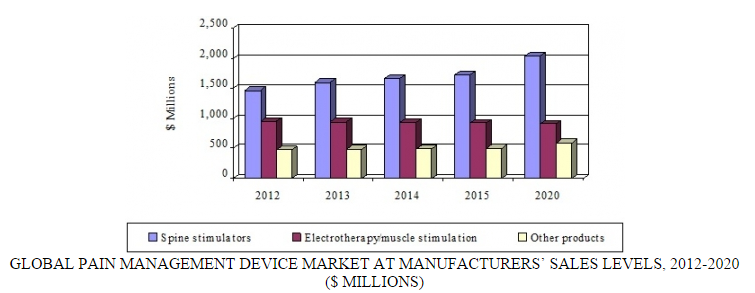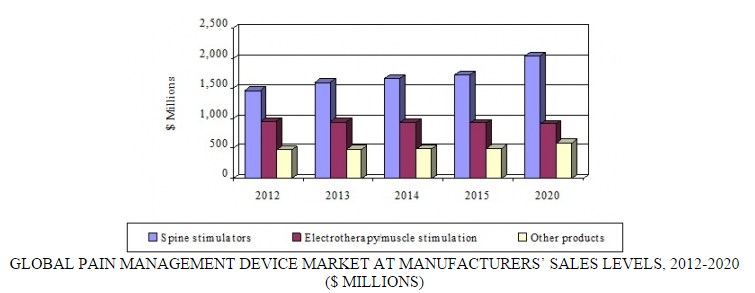
Oct 26, 2015
Blog Life Sciences Pharmaceuticals Lead Pain Management Market, Devices Gaining Share
The pain management (PM) market is diverse, offering a wide range of products and services that treat and ease pain. The total market comprises of PM prescription pharmaceuticals and PM devices -- and each of the individual segments within these broad categories influences the total market.
In large part, growth is being driven by an aging global population and rising rates of cancer and chronic illness such as diabetes and cardiovascular disease. A reduction of regulatory and cost issues attributed to decreasing hospital stays as an increasing range of health services -- including pain management -- are handled on an outpatient basis and in the home is also beginning to have a significant impact.
According to BCC Research’s The Global Market for Pain Management Drugs and Devices (HLC026E), the overall market for pain management drugs and devices is expected to reach $37.8 billion in 2015 and $44.3 billion by 2020, reflecting a steady five-year compound annual growth rate (CAGR) of 20.7%.
Pain management pharmaceuticals account for the largest percentage of revenues in 2015, with about 92% market share, or $34.6 billion for the year. PM devices accounted for a smaller, yet essential portion of the 2015 market, accounting for the remaining 8%, or $3.1 billion.
“Pain management pharmaceuticals will continue to dominate the worldwide pain management market,” said BCC healthcare analyst Melissa Elder. “Recent advances in technology, however, are helping to drive growth in the PM device markets.”

Source: BCC Research, "The Global Market for Pain Management Drugs and Devices," September, 2015
PAIN MANAGEMENT PHARMACEUTICALS
Generally speaking, prescription pain management products are divided into five general categories: narcotics analgesics; non-narcotic analgesics; antimigraine agents; anesthetics; and other drug classes.
According to BCC Research, total sales for PM drug manufacturer in 2015 are expected to reach $34.6 billion, having experienced steady growth due to an increase in the number of patients needing pain control for either surgical procedures or chronic conditions. This is an increase over the 2012 market of $32.6 billion. In 2020, the prescription pain market is projected to grow to nearly $40.8 billion and register a healthy 3.3% CAGR.
This market is expected to grow steadily over the near term, as physicians take a more aggressive approach to pain control. Indeed, growth is expected to be particularly strong in the migraine market and the other treatment market, while sales in the anesthetic, narcotic and non-narcotic segments are expected to remain relatively stable. New product introductions also will influence growth through 2020.
Because the continued success of this segment of the overall PM market is dependent on the introduction of new products, research and development is vital to pharmaceutical manufacturers. Companies must continually reinvest money from sales into R&D in order to maintain an active new product pipeline.

Source: BCC Research, "The Global Market for Pain Management Drugs and Devices," September, 2015
PAIN MANAGEMENT DEVICE MARKET SIZE AND ANALYSIS
The pain management device market is divided into three major segments: TENS units/neuromuscular stimulators, spinal cord stimulators, and other products -- including electrothermal and electromagnetic devices and other advanced technologies.
Of these three segments, the nerve stimulator and TENS market is moving toward saturation, whereas spinal cord stimulators (SCS) are being steadily adopted and the market continues to show prospects for growth.
According to BCC Research, the total PM device market will reach $3.1 billion in 2015 and register a stable CAGR of 2.3% over the next five years to reach $3.5 billion in 2020. Technological advancements and increasing device sophistication are expected to generally increase market revenues over the near term despite saturated market conditions in some segments.
The number of pain management devices available is also expected to increase as device technology evolves. As new technologies are introduced with additional features that focus on patient use, safety and modes of operation to provide increased analgesic effect, the market is poised for healthy growth.
Manufacturers of pain devices aimed at alternate sites and developers of outpatient pain device products will experience healthy growth due to the current cost-conscious environment.

In today’s fast-paced biomedical world, researchers and pharmaceutical companies...

Radiopharmaceuticals represent a cutting-edge frontier in modern medicine, offer...

Implantable Remote Patient Monitoring (IRPM) devices are revolutionizing healthc...

We are your trusted research partner, providing actionable insights and custom consulting across life sciences, advanced materials, and technology. Allow BCC Research to nurture your smartest business decisions today, tomorrow, and beyond.
Contact UsBCC Research provides objective, unbiased measurement and assessment of market opportunities with detailed market research reports. Our experienced industry analysts assess growth opportunities, market sizing, technologies, applications, supply chains and companies with the singular goal of helping you make informed business decisions, free of noise and hype.